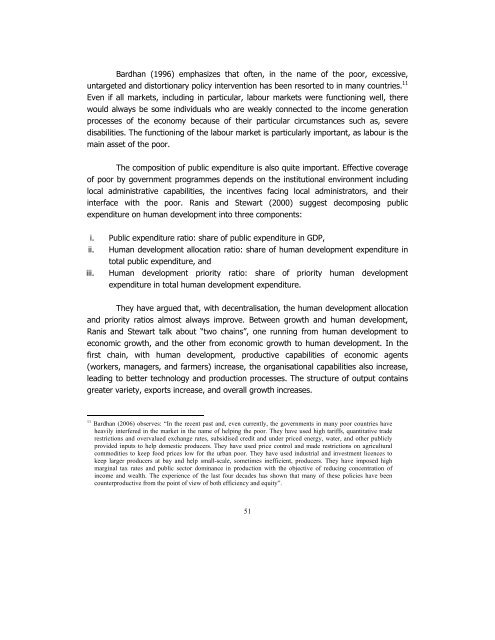POVERTY REDUCTION STRATEGY TN
You also want an ePaper? Increase the reach of your titles
YUMPU automatically turns print PDFs into web optimized ePapers that Google loves.
Bardhan (1996) emphasizes that often, in the name of the poor, excessive,<br />
untargeted and distortionary policy intervention has been resorted to in many countries. 11<br />
Even if all markets, including in particular, labour markets were functioning well, there<br />
would always be some individuals who are weakly connected to the income generation<br />
processes of the economy because of their particular circumstances such as, severe<br />
disabilities. The functioning of the labour market is particularly important, as labour is the<br />
main asset of the poor.<br />
The composition of public expenditure is also quite important. Effective coverage<br />
of poor by government programmes depends on the institutional environment including<br />
local administrative capabilities, the incentives facing local administrators, and their<br />
interface with the poor. Ranis and Stewart (2000) suggest decomposing public<br />
expenditure on human development into three components:<br />
i. Public expenditure ratio: share of public expenditure in GDP,<br />
ii. Human development allocation ratio: share of human development expenditure in<br />
total public expenditure, and<br />
iii. Human development priority ratio: share of priority human development<br />
expenditure in total human development expenditure.<br />
They have argued that, with decentralisation, the human development allocation<br />
and priority ratios almost always improve. Between growth and human development,<br />
Ranis and Stewart talk about “two chains”, one running from human development to<br />
economic growth, and the other from economic growth to human development. In the<br />
first chain, with human development, productive capabilities of economic agents<br />
(workers, managers, and farmers) increase, the organisational capabilities also increase,<br />
leading to better technology and production processes. The structure of output contains<br />
greater variety, exports increase, and overall growth increases.<br />
11 Bardhan (2006) observes: “In the recent past and, even currently, the governments in many poor countries have<br />
heavily interfered in the market in the name of helping the poor. They have used high tariffs, quantitative trade<br />
restrictions and overvalued exchange rates, subsidised credit and under priced energy, water, and other publicly<br />
provided inputs to help domestic producers. They have used price control and made restrictions on agricultural<br />
commodities to keep food prices low for the urban poor. They have used industrial and investment licences to<br />
keep larger producers at bay and help small-scale, sometimes inefficient, producers. They have imposed high<br />
marginal tax rates and public sector dominance in production with the objective of reducing concentration of<br />
income and wealth. The experience of the last four decades has shown that many of these policies have been<br />
counterproductive from the point of view of both efficiency and equity”.<br />
51

















